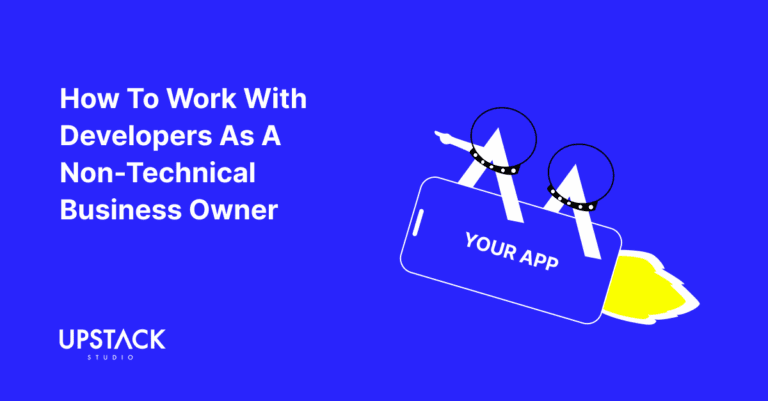Not Every App Idea Can be Bootstrapped
Say you’re an experienced founder with successful small-scale apps under your belt.
And now, you want more.
You want your next app to have a bigger impact.

Too bad your vision requires resources that a measly bootstrap budget can’t sustain.
Time to learn how to win over and leverage external support!
This isn’t limited to financial resources alone – the right support can come in the form of:
- guidance & advice on avoiding common pitfalls
- industry insights
- connections to their extensive network
But yes, the most important would probably be lots and lots of money!
Remember that investors come in all shapes and sizes.
Some live and breathe tech – others might not even know what ‘API’ stands for!
This post provides the six key steps you need to take to secure buy-in from investors and get your app idea the support it needs.
Step 1: Understanding Your App Idea
Understanding your app idea is crucial – you already know that.
But when you speak to investors, you need to understand how it can shape the world – just how big is the scope of impact here?
Investors, for the most part, are logical thinkers, so skip the gimmicks (OpenAI spammers, looking at you).
They want to know what problem your app will solve – the bigger the problem, the bigger the total addressable market.
These are some questions that you should be providing solid answers to:
- How will it genuinely enhance people’s lives?
- How will it add value in a space that’s saturated with apps vying for attention?
- What competitive advantage do you have to protect against competition?
Your idea needs to be special, but it also needs to be practical and profitable.
Step 2: Protecting Your App Idea
Speaking of competitive advantage, one of the best things you can do is protect your app idea with trademarks and patents.
Trademarks give you exclusive rights to your brand name and logo that set your app apart.
Patents secure your intellectual property and make it illegal for other founders to copy your app idea.
These rights are also licensable, meaning you can grant others permission to use your brand and name for a price.
To investors, this means:
- a competitive advantage
- a diversified revenue stream from licensing options
Above all else, it is a clear demonstration of commitment and intelligence from you as a founder.
Step 3: Building a Prototype of Your App
Remember, investors are logical thinkers who seek hard evidence of success before signing a cheque.
And so, a robust prototype or a minimum viable product (MVP) will say far more than even the fanciest of presentation slides.
By providing a way to tangibly interact with your app’s idea, you are making it easier for them to see its potential.

We strongly recommend that you show the prototype to testers first and make iterations based on their feedback.
When you finally show it to potential investors, being able to tell them of positive real-user interactions will make a tremendous impact on their impression of your app
Once again, this also shows that you’re committed and serious about the project.
Step 4: Pitching Your App Idea
Shark Tank time!

Remember: few things sway investors like evidence.
Ideally, your presentation should show them:
- Current and forecasted sales figures
- Marketing channels
- Detailed breakdown of how their investment will be spent
- Potential growth opportunities
- Competitor analysis
- User demographics
- Revenue model
- Product development roadmap
- Risk assessment
Also, keep in mind that you need to incorporate a company and document that the app idea and all future versions belong to the business – not you as an individual.
That gives investors more confidence, and many won’t deal with anything but a company where ownership of the app is based on shareholding.
That leads us to the next step.
Step 5: Negotiating and Closing a Deal
Say you’ve roped yourself a potential sucker – sorry – we meant to say potential investor.

Time to enter negotiations and fingers crossed, close the deal.
If investors see potential in your app, they will be happy to throw money at you in exchange for a chunk of equity.
So long as you’ve done your homework, stand behind what you believe your app is worth.
Remember, there’s no rush to sell your idea off just yet – here are some common negotiation strategies:
A win-win situation
People prefer outcomes that appear beneficial to all parties involved.
Show your potential buyer not only how your app benefits you, but how it can also add value to them.
Anchoring
Set a well-considered, preferential initial price as an anchor.
This becomes a psychological reference point for all negotiations to follow.
Door-in-the-face
Propose an intentionally high request (that you expect to get refused) before making your actual, more reasonable proposition.
This can make the second request seem much more feasible.
Step 6: Considering Legal & Financial Aspects
What if…
- Your investor suddenly sells their shares to a third party who turns out to be a competitor?
- The app fails to do as promised and an angry user files a lawsuit?
- Your app is hacked and important user data is stolen and held ransom?
Depending on your app idea, it may be worth consulting a legal expert who can advise you on areas of concern and draft customised documentation.
For example, did you know Meta and many major software companies have different share types that grant different levels of voting power?
Shares can even be set up to be convertible one way, usually from a type with more voting power to one with less, but not the other way around.
This allows a company to raise funds without sacrificing control.
There are a million ‘what ifs’ that are impossible to predict without the benefit of hindsight.
Statutory and legal compliance is no laughing matter.
Conclusion: Selling Investors on an App Idea is HARD!
Let’s conclude with a quick recap of the six key steps outlined above:
- Thoroughly grasp the concept of your app idea
- Protect your app idea with a patent claim
- Develop a prototype of your app and test it
- Practice your app idea pitch
- Be firm when negotiating a deal with interested parties
- Take into account the legal and financial factors
Realizing a successful app from a mere idea can seem an overwhelming task, but with sufficient legal protection, a well-built prototype and a compelling pitch, it’s absolutely achievable to get the right backing to make your big app idea a reality.
Hey there stranger, thanks for reading all the way to the end. Consider joining our mailing list for a one-stop resource on everything from micro SaaS validation all the way to execution and promotion. Get a nifty list of questions to ask app developers when you sign up!
Download this template now so you know exactly what to ask App Development Agencies! Let us know where should we send it through the form below.







